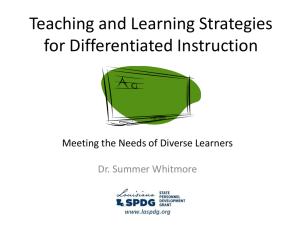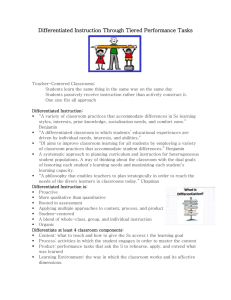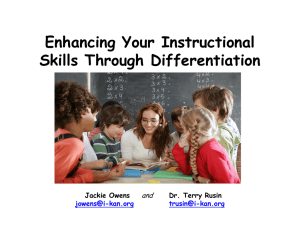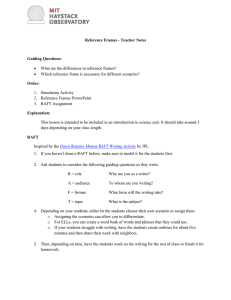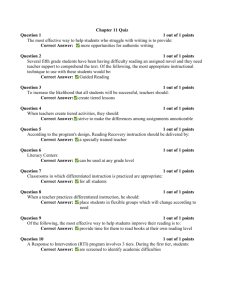Differentiated Instruction Strategies for Diverse Learners
advertisement
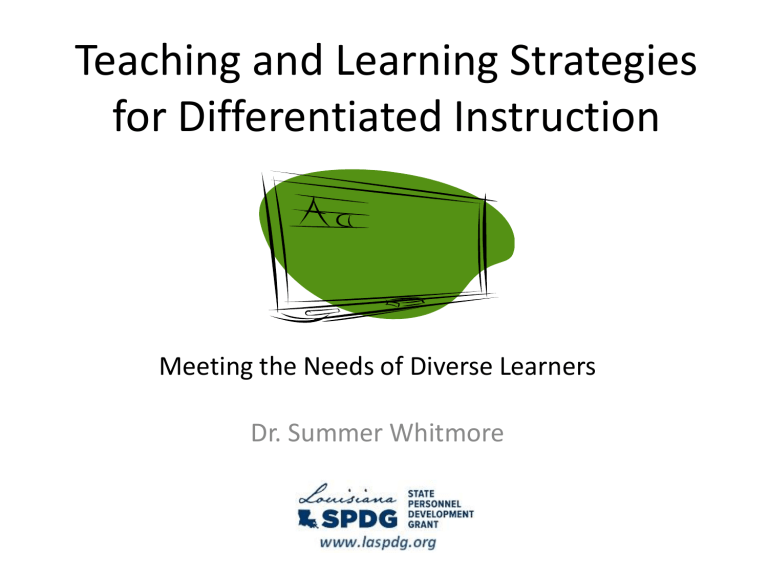
Teaching and Learning Strategies for Differentiated Instruction Meeting the Needs of Diverse Learners Dr. Summer Whitmore Attendance • At this time, if you have not already done so, please use your chat pod and type the district/LEA you are representing • If you are viewing this webinar with others in the room, please indicate their name as well Considerations • This webinar is being recorded and will be available for viewing at www.laspdg.org under Culturally Responsive Practices Webinars 2014-2015 • If you need to ask a question, please use the Chat Pod on your screen (NOTE: everyone can see your question) • You can download all of today’s materials in the FILES 2 Pod on your screen at any time during the presentation – Click on the selected file – Choose “SAVE TO MY COMPUTER” – Select the destination where you would like to save the file People First Language “People First Language puts the person before the disability and describes what a person has, not who a person is.” Kathie Snow. (n.d.) A few words about People First Language. Disability is Natural. Retrieved August 1, 2012 from http://www.disabilityisnatural.com/images/PDF/pfl-sh09.pdf • Gain knowledge of the essential elements of differentiated instruction. • Gain knowledge related to tiered assignments, role-audience-format-topic, and think-tac-toe. 5 What do you already know? In an effort to better understand participant knowledge level, please take a moment to answer these pre-questions that will appear on your screen: Differentiated Instruction • Differentiated instruction is based on the assumptions that students differ in their learning styles, needs, strengths, and abilities, and that classroom activities should be adapted to meet these differences. Differentiated Instruction Is……. • effective instruction that is responsive to the learning preferences, interests and readiness of the learner • an organized framework for teaching and learning • responds to the need of the student by providing a balance of shared, guided, and independent instructional strategies DI means…….. DI does not mean………. Flexible, short term groupings that allow students to work with a variety of peers with the same or different strengths and interest. Labelling students or grouping by ability Engaging and interesting tasks for all learning preferences, interest and levels of readiness Confining some students to low level, repetitive or rote tasks while others engage in higher-order thinking A reasonable number of well constructed choices that address identified needs/strenghts of students Different students working on different expectations with varying success criteria (e.g., different rubrics) Students learning about themselves to help them make effective and informed choices Teachers assuming responsibility for making all decision regarding student choice Routines, procedures, and classroom agreements are in place A chaotic or unstructured classroom environment Differentiation-How does it Work? • Teachers can differentiate at least four classroom elements based on student readiness, interest, or learning profile: • Content • Process • Product • Learning environment Content What the student needs to learn or how the student will get access to the information? 12 Content Examples • • • • • • Reading materials at varying readability levels Text materials on tape Spelling/vocabulary lists at readiness levels Ideas through both auditory and visual means Reading buddies Small groups to re-teach an idea or skill for struggling learners, or to extend the thinking or skills of advanced learners 13 Process Activities in which the student engages in order to make sense of or master the content. 14 Process Examples • Tiered activities at different levels of support, challenge, or complexity. • Centers that encourage students to explore subsets of the class topic of particular interest to them. • Manipulatives for students who need them. • Varying the length of time a student may take to complete a task- for a struggling learner or an advanced learner to pursue a topic in greater depth. 15 Product Culminating projects that ask the student to rehearse, apply, and extend what he or she has learned in a unit. 16 Product Examples • Giving students options of how to express required learning (e.g., create a puppet show, write a letter, or develop a mural with labels). • Using rubrics that match and extend students’ varied skill levels. • Allowing students to work alone or in small groups on their products. • Encouraging students to create their own product assignments as long as the assignments contain required elements. 17 Learning Environment The way the classroom works and feels. In addition, it’s the way the classroom and/or school, creates a sense of community 18 Learning Environment Examples • Places in the classroom to work quietly without distraction, as well as places that invite student collaboration • Materials that reflect a variety of cultures • Guidelines for independent work that matches individual needs • Routines that allow students to get help when teachers are busy with other students Strategies for Differentiation • • • • • • • • • Higher Prep Tiered Lessons RAFT Think-Tac-Toe Multiple Intelligence Options Graphic Organizers Response/Exit Cards Multiple Texts Flexible Grouping • • • • • • Lower Prep Reading & Study Buddies Anchor Activities Think-Pair-Share Choices of books Interest Surveys Multiple Levels of Questioning Three Differentiation Strategies Tiered Instruction RAFT Role-AudienceFormat-Topic Think-Tac-Toe TIERED INSTRUCTION What is Tiered Instruction? Provides teachers with a means of assigning different tasks to students within the same lesson or unit. • The tasks will vary according to the students’: • Readiness • Interest • Learning Profile Tiered Instruction & Common Core • All students focus on the skills of common core but at different levels of complexity. • Keeping the focus of the activity the same, but providing routes of access at varying degrees of difficulty will maximize each student being challenged. Tiered Instruction Example Students are to understand the effect of global warming. Tier 1 Students write a public service announcement using jingles, slogans, or art to convey why global warming is a problem and what people can do to prevent it. Tier 2 Students conduct a survey of peer awareness and understanding of global warming. They design questions and report their results using charts and news format. Tier 3 Students debate the issue about global warming, each side expressing a different viewpoint with credible evidence to support the argument. What Can be Tiered? • • • • • • • • Assignments Activities Homework Centers Experiments Materials Assessments Writing Prompts When Tiering Adjust… • • • • • • • Level of Complexity Amount of Structure Materials Time/Pace Number of Steps Form of Expression Level of Dependence Tiered Assignments Video http://youtu.be/1ob4eGz04G4 Or http://youtu.be/nPb4owVY-M0 RAFT ROLE-AUDIENCE-FORMAT-TOPIC What is RAFT? • Have any of you heard of and/or used Raft in your classroom? RAFT is… • an engaging, high level strategy that encourages writing across the curriculum • a way to encourage students to… – assume a role – consider their audience – write in a particular format – examine a topic from a relevant perspective The RAFT Strategy… • forces students to process information • allows for more creative responses to learning the materials • gives students choice, appealing to their interests and learning profiles Choice Variations RAFT • RAFT Writing Strategy (JHAT, Jr.) http://youtu.be/OLJ_32y6lR0 Common Core and RAFT Example • American Revolution-students in 8th grade must analyze the events leading up to the revolution. Students must be able to determine the causes and effects. RAFT Topic- What’s Worth Fighting For? ROLE AUDIENCE FORMAT TOPIC Patriot Town Folks Speech “Get on my side!” Loyalist English Relative Post Card What is happening in the colonies G. Washington Patriot Soldier News Letter Why join the fight Soldier Wife, Martha Letter or Poem What a great leader GW is King George His Subjects Political Cartoon Making fun of the AR RAFT-Sample Roles & Audience • • • • • • • • • • • Ad agencies Athletes Cartoonist Editors Pen Pals Animals Historical figures TV Characters Doctors Lawyers Politicians • • • • • • • • • • Poets Plants Parents Historical events Literary characters Body parts Binoculars Rear-view mirrors Musicians Artists • Branches of the Government • Presidents • Military figures • Husbands/wives • Famous cooks • Political activists • Freedom fighters • Authors • Heroes • Villains • Frontiersmen 37 RAFT-Format • • • • • • • • • • • • • Advertisement Anecdote Application Blurb Board game Brochure Critique Dear Abby letter Debate Dialogue Directions Editorial E-mail • • • • • • • • • • • • Epitaph Free verse poem Graffiti Greeting card Instructions Interview Journal entry Lecture Letter List Map Math problem • • • • • • • • • • • • • Motto News article Picture Post card Poster Puzzle Screen play Ship’s log Skit Song Speech Telegram Wanted poster 38 THINK-TAC-TOE What is Think-Tac-Toe • A simple way to give students alternative ways of exploring key ideas • Designed to help students think about a topic from different angles • Game-like—motivates children • A grid consisting of 9 or more boxes Think-Tac-Toe Setup • It does not matter the choices students make, they must work with key ideas and use the key skills central to the topic. Think-Tac-Toe & Common Core Knowledge list, define, tell, describe, identify, show, label, collect, examine, quote, name, who, when, where Comprehension summarize, describe, interpret, contrast, predict, associate, distinguish, estimate, discuss, extend Application apply, demonstrate, calculate, complete, illustrate, show, solve, examine, modify, relate, change, classify, experiment, Analysis analyze, separate, order, explain, connect, classify, arrange, divide, compare, select, explain, infer Synthesis combine, integrate, modify, rearrange, substitute, plan, create, design, invent, what if?, compose, formulate, prepare, generalize, rewrite Evaluation assess, decide, rank, grade, test, measure, recommend, convince, select, judge, explain, discriminate, support, conclude, compare Comprehension or Evaluation Application or Evaluation Knowledge or Analysis Algebra Think-Tac-Toe Board Summarize the most important information about linear functions and put it to a beat. Draw the sequence of events to graph a linear equation on a timeline. Create a way to remember how to graph linear equations given in standard form. Reflect on the application of linear functions to something in your life in your journal. WILD CARD !!! Your choice after getting approval. Create a series of at least six cartoon frames to capture the most important information about linear functions. Condense the information about linear functions and create an advertisement, banner, or slogan. Act a short skit that conveys the life of a linear function. Write a poem that conveys the main ideas about linear functions. Implementing Differentiated Instruction • Develop Instructional Routines – Identify your own learning preferences and your students using inventories and observations – Deliberately plan part of a lesson so that it appeals to a learning preference that you do not usually address Implementing Differentiated Instruction • Expand Routines and Skills – Determine ways of learning that motivate your students the most – Over several days provide the class with learning experiences that introduce them to different ways of learning and allow you to observe which opportunities work for which students Implementing Differentiated Instruction • Sustain a Differentiated Instruction Culture in the Classroom – Challenge students to experiment with other ways of learning – Reflect on what helps to engage students and respond by refining your instructional approaches. Additional DI Webinars www.laspdg.org – Inclusive Practices Webinar – 2012-2013 Webinars Titles – Flexible Grouping – Cubing & Think Dots – Choice Boards – Learning Materials Building Capacity • When you leave today, what will you do with this information? • How will you share it with others in your district? • When will you share it? (Timeline) Note: If you are on the district leadership team, this information will be useful in completing your district’s LASPDG 5 Year Plan 48 Let’s Take a Poll! Please take a moment to answer these post-questions regarding your knowledge: Questions? Please use your chat pod if you have questions related to this presentation • You may email any questions to Summer Whitmore swhitm1@lsu.edu Thank you for participating in today’s webinar! www.laspdg.org The contents of this PowerPoint presentation were developed under a grant from the US Department of Education, #H323A110003. However those contents do not necessarily represent the policy of the US Department of Education, and you should not assume endorsement by the Federal Government.
